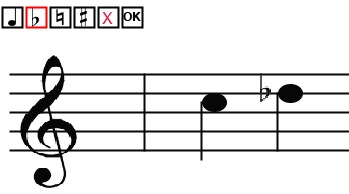Playing Minor 2nds by Ear Down
Now you will learn to hear Minor 2nds played as a chord.
This makes a very rough sound which we call Dissonance
This makes a very rough sound which we call Dissonance
| Minor 2nd - Chord |
Minor 2nds Playing by Ear Down
Now we will practice playing Minor 2nds by ear going down.
Here are several examples of descending Minor 2nds.
Here are several examples of descending Minor 2nds.
Piano Writing Minor 2nds Chord
Playing Minor 2nds by Ear
Now we will begin our first lesson in Ear Training.
Ear Training develops your ability to hear a sound and immediately recognize it.
The is one of the most important skills for anyone who wants to become the UltraMusician.

Ear Training develops your ability to hear a sound and immediately recognize it.
The is one of the most important skills for anyone who wants to become the UltraMusician.

In this lesson, you will hear a Minor 2nd, then you will play it on your instrument.
Piano writing Minor 2nds Down
Now we will apply the same logic, except this time writing Minor 2nds going down
Remember that between EF and BC there is no accidental.

Remember that between EF and BC there is no accidental.

Writing Minor 2nds by Name
Now we will learn to write Minor 2nds by name.
The challenge here is to know when to add sharps or flats.
As you probably remember from the previous exercises, some natural notes have accidentals in the middle, while others do not:
The challenge here is to know when to add sharps or flats.
As you probably remember from the previous exercises, some natural notes have accidentals in the middle, while others do not:
Writing Minor 2nds
Now you will learn to write Minor 2nds using the Notation Tool.


There are many kinds of intervals, such as 2nds, 3rds, 4ths, etc.
Reading Minor 2nds Chord
Now we will play Minor 2nds as chords.
A chord is two notes played at the same time.
The technical name for a two note chord is a diad.
A chord is two notes played at the same time.
The technical name for a two note chord is a diad.
In music notation, a diad looks like this: